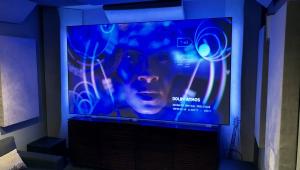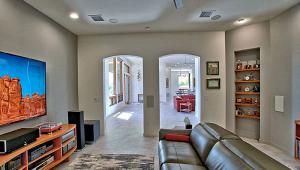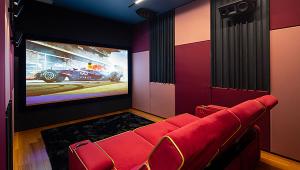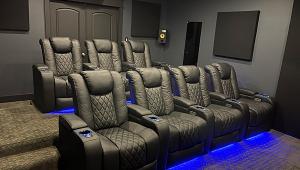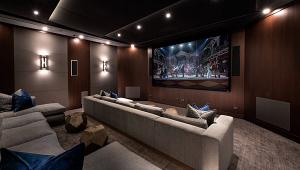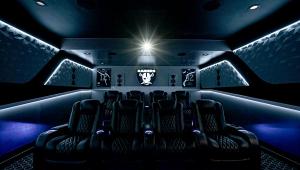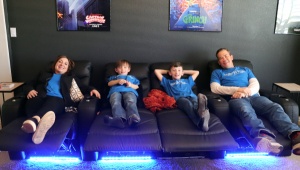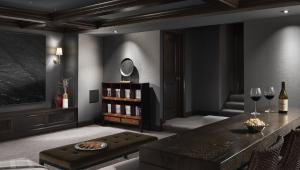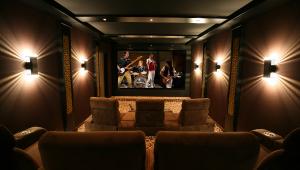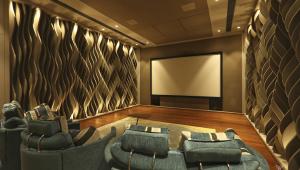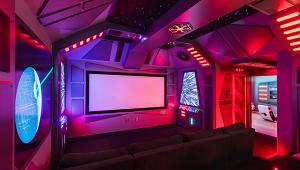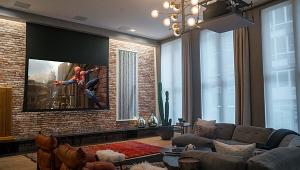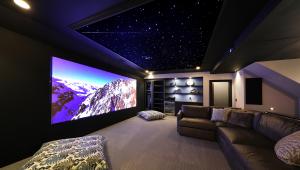5 inch subwoofers-you gotta be kidding. somebody look up what WFO stands for and you will have my opinion
Little Big Screen
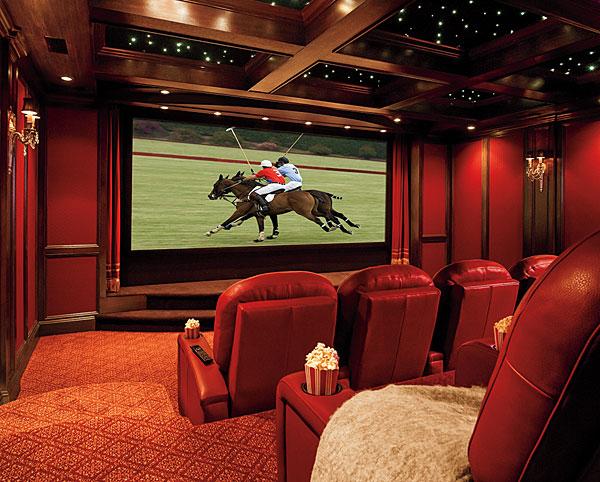
At the highest level of execution, building a home theater is an expression of fine art, an engineering as well as aesthetic endeavor that combines technical know-how with inspired interior design, all with the idea of creating a room that wows its inhabitants no matter if the lights are on or off. The end game of a great theater room can be summed up in a single word: impact.
Impactful is an apt description for the project you see here. It was built within a 15,000-square-foot estate home on 9 acres in the rolling hills of Bernardsville, New Jersey, as part of a full basement renovation that also included a banquet room, wine cellar/tasting room, workout area with steam shower, home office, and full kitchen. Surprisingly, given the opulence that surrounds it, it’s not a huge theater. After builder Scott Roberts of Tewksbury Township, NJ, squared away all the other spaces, he and the homeowners settled on a 20 x 24-foot room. But that didn’t stop integrator iTEC Consultants, of Matawan, NJ, from going big—really big—with the visuals. Despite the tight dimensions, the theater features a gigantic 176-inch-diagonal (162-inch-wide), 2.35:1 CinemaScope screen.

How that came about is a story we’ll get to. But I’ll add here that Sound & Vision was lucky enough to be there to see this unusual and elegant room come together from almost the beginning. I visited the site several times, shooting video and watching the construction crew and the team from iTEC negotiate through the various stages of the build. You’ll find a more detailed description of the project, along with additional progress shots, video of the construction, and a full equipment list, on our Website at soundandvision.com. Just click on Installs from the navigation bar and select “Home Movie Theaters” from the drop-down menu. Appropriately, we’ve dubbed the project “Little Big Screen.”

How Big Can You Go?
When iTEC project consultant Joe McNeil first sat with the owner of this theater to discuss the parameters, he posed the same question he asks everyone.
“When we met,” says McNeil, “I asked, ‘When you go to the movie theater, where do you like to sit?’ Right off the bat, he said ‘Front row. I wanna be right there!’ His immediate priority was getting the largest possible screen in his room.”

Initially, the homeowner was enamored with the idea of a full-width, ceiling-to-floor screen. But given the number of viewers he wanted to seat, McNeil knew that such a wide and low-reaching vista wouldn’t be plausible without impeding sight lines. Projector throw distance could also be problematic when trying to project such a large image across a relatively short space, and design considerations had already dictated that the screen be on the longer of the two room dimensions—this to accommodate a movie-theater-like ramp entryway that would help isolate sound and light while used during a movie.
McNeil wanted to help the homeowner visualize what was really possible and how engaging the image could be. So, early in the design process, when the room was still just open studs, he took the unusual step of setting up a test run. He hauled in working samples of the Digital Projection M-Vision Cine400 projector and Panamorph UH480 anamorphic lens that iTEC intended to spec for the job, along with a Blu-ray player and a full-size home theater seat. The projector was propped up in the intended location, the seat placed dead center in the back row, and a large painter’s drop cloth was hung up to act as a screen. The appropriate screen size was immediately obvious, and the client was satisfied. “You know the expression about a picture being worth a thousand words?” says McNeil. “Well, a projector and a painter’s tarp is worth a novel.”

Plans were initially drawn up for an 11.4-channel system, but this was eventually scaled back to a 9.4-channel setup with high-performance Episode in-wall speakers used for the main and surround channels. Three ES-HT900-IWLCR-6 speakers are hidden behind the acoustically transparent Vutec Vision X screen for front left, center, and right channel. These feature a pair of 6.5-inch woofers utilizing the company’s NCS cone material and a 4.65-inch, magnetic planar membrane tweeter in a fully sealed back box. The ES-HT700-IWLCR-6 in-walls, each with a pair of 6.5-inch paper/Kevlar woofers and a 1-inch titanium-dome tweeter in a similar sealed enclosure, are used for two pair of left/right surrounds on the side walls corresponding to each row of seats, and another pair of back surrounds is located on the rear wall. Two Artison RCC600-SM in-wall subs in back boxes, each featuring four 5-inch woofers in opposing pairs, flank the proscenium up front, while a second pair are mounted on the side walls near the second row of seats. All the surrounds and subs are hidden behind fabric wall panels.
A Marantz AV7701 preamp/processor and a pair of XLR-connected MM7705 five-channel amplifiers rated at 140 watts per channel drive the mains and surrounds; two Episode subwoofer amps each handle a pair of subs. The equipment rack is situated across the outer hallway from the theater in a utility room and houses a cable set-top box and Apple TV streaming media player. Other source components that require local access, including a Samsung Blu-ray player and both Xbox One and PS4 game consoles, are stealthily hidden in a compartment behind a spring-loaded hinged panel at the top of the theater’s entry ramp. Lighting and theater control are provided by a Control4 wand remote and tablet app tagged to a dedicated HC-800 processor.

The recessed projector housing in the theater’s rear wall was cleverly designed for forced-air cooling. Since the housing backs into the ramped entry hallway, the iTEC crew had the general contractor cut a decorative vent into the side of the bump-out at the spot that directly corresponds to the projector’s cool-air intake. A fan pulls the hot air directly from the outtake and vents it via flexible ductwork into another large utility closet behind the theater. Despite the tight space and heat it generates, the projector runs for hours every day with no trouble. Similarly, it was decided early in the project to put the theater on its own dedicated HVAC zone, and to heavily insulate the ductwork, to ensure that the forced-air AC and heat came on quietly and did not disturb the inhabitants.

The Devil in the Details
Beyond the humongous screen, fine execution of detail and outstanding construction really make the Little Big Screen theater something special. Classic movie-theater red was selected as the color motif for the motorized velvet curtains, carpeting, acoustic wall panels, and motorized leather recliners. The trim around the wall panels and the coffered ceiling were handcrafted one piece at a time in stunning mahogany under the aegis of lead millworker Rainer Boettcher of Holland Master Builders in Milford, NJ. As an added touch, the nine 5 x 4-foot sections of the ceiling contain black fiberoptic star panels designed and built by Richard Charschann’s team at Acoustic Smart Home Theater Interiors, a manufacturer of custom theater interiors in Merrick, New York, that was also tapped for the wall panels, drapery installation, and seats. The ceiling uses 18,000 feet of fiber (with the longest run at 45 feet) and features two light engines mounted in the closet behind the theater, one to make the stars twinkle, the other to randomly generate shooting stars. It’s programmed to come on automatically when the system starts up; with the push of a button, the wall sconces dim and the stars come out. They can also be manually switched on or off via the Control4 system.

The Little Big Screen theater took several months to complete, though it probably wasn’t more than a couple weeks of work in total on site for iTEC project managers Mario Rodriguez and Victor Marques, technicians Jonathan Carter and Peter Mikulak, and their affiliated trade part- ners. This isn’t unusual on large jobs like this as carpenters, electricians, insulation specialists, and other resources are moved around the project. Construction of the theater was coordinated with the rest of the work in the surrounding basement and went in phases. As is typical, many details needed to be worked out in advance to avoid problems later. For example, the iTEC crew fortunately thought ahead and knew that the drapery track and the extra large screen—even rolled up—would never make the turn at the top of the theater’s entry ramp once the room was finished. To accommodate, one section of a stud bay in an appropriate location was left open for passage until the project neared completion. Similarly, all the mahogany moldings that hold the acoustic wall and ceiling panels in place were measured, cut, finished, and coded for position in advance and only then brought into the theater to ensure the room and panels stayed pristine in the final push to finish.

Of course, no job like this runs perfectly from start to finish, and the iTEC team encountered the occasional glitch—a stud or two that needed to be moved to accommodate proper positioning of a speaker or acoustic panel, a wire inadvertently buried behind a plywood panel by the construction crew, that sort of thing. But this is part of the game in any theater project, and in the end, there was nothing insurmountable. The final result was a gorgeous theater with an immense, engrossing image, and a happy client who escapes to it daily. Impactful? You bet. That’s the best kind of impact there is.
- Log in or register to post comments


No mention of the projector hardware/model? Tsk tsk.


Dur. Should have seen that :)

I have 48, 4-inch subwoofer drivers in my HT and they sound great! Check out the BG Radia system review a couple of years back, I bought it based on the HT review and it is absolutely fantastic! Completely transparent and great extension.
http://www.soundandvision.com/content/bg-radia-bgx-4850-wall-subwoofer-s...
Chuck
